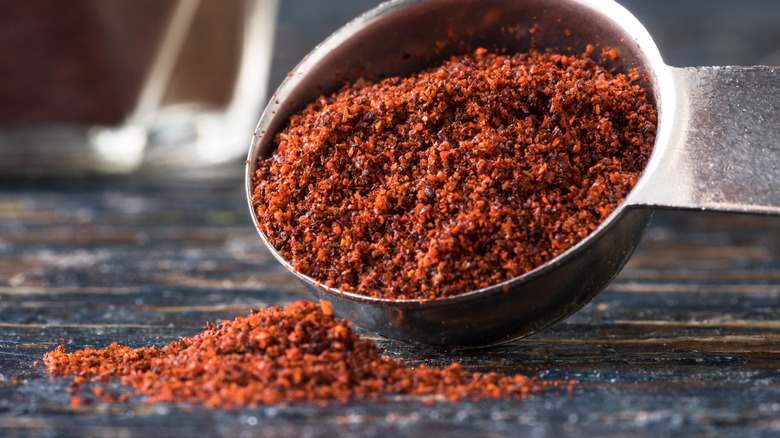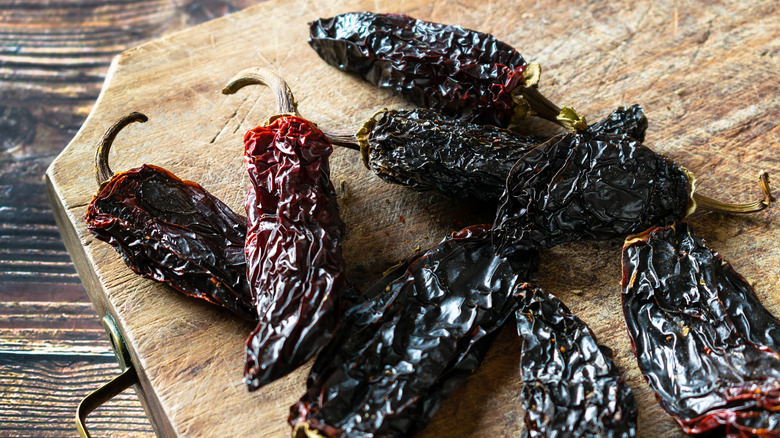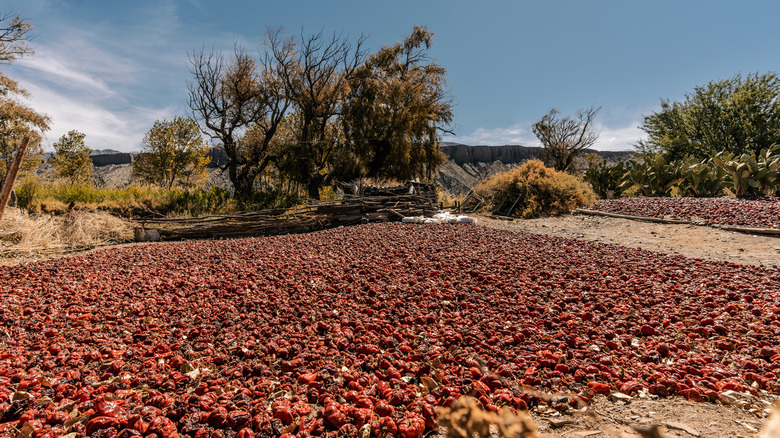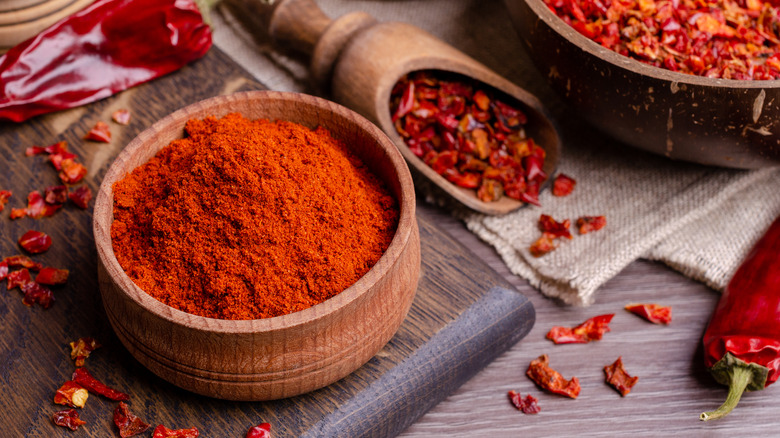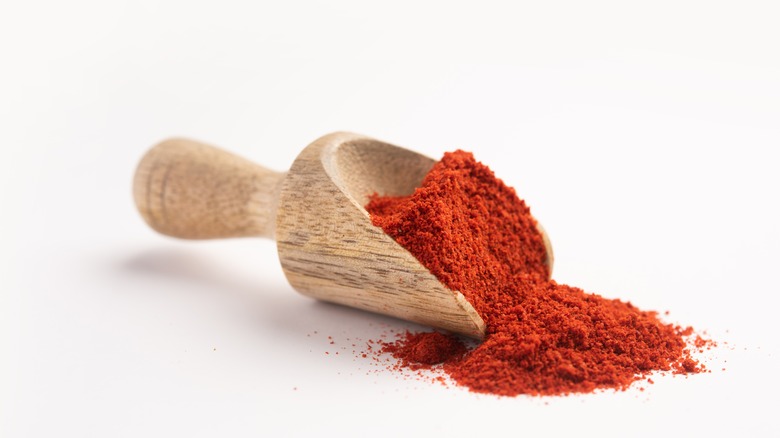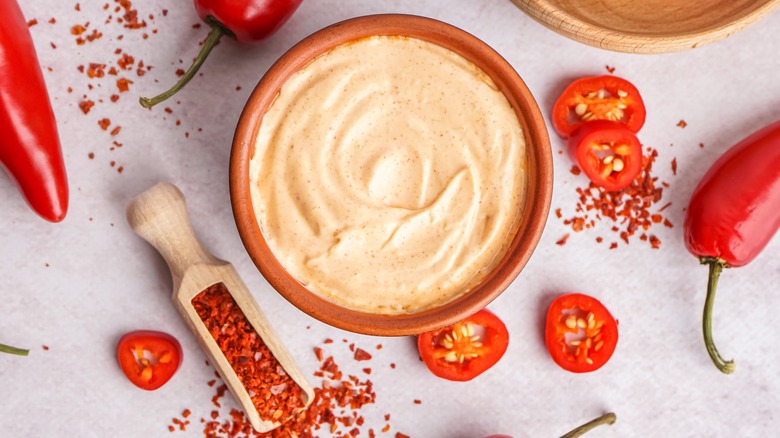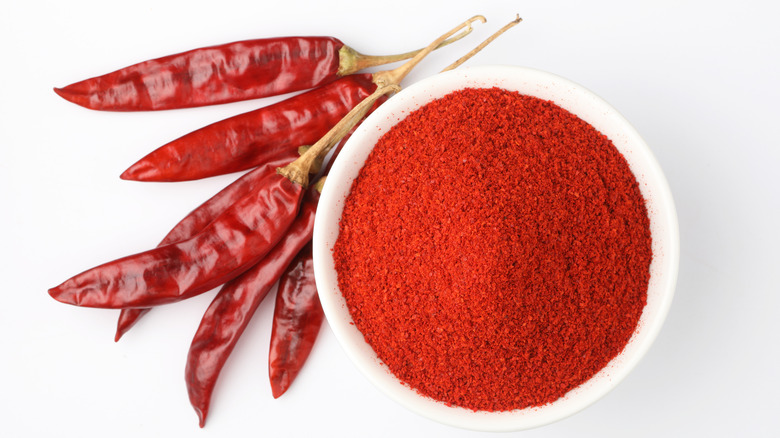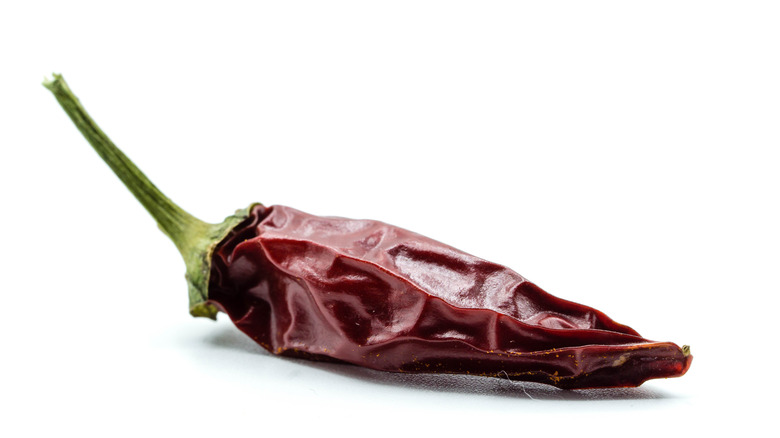What Is Chipotle Powder And How Is It Best Used?
Not only do peppers exist in a dizzying array of sizes, shapes, and flavors, but they can also go through a variety of different processing methods before they end up on your table. Whether dried or marinated and pickled, the fruit does well with preservation — and when it comes to ease of use and shelf-life, it's hard to beat powdered versions.
For a dried pepper with a bold punch, turn to chipotle powder. An attractive deep orange in color, this spice offers a delicious dose of smoky, spicy, and earthy flavors. Although many Southwestern recipes reach for the pepper in canned form, the spiced version eases use without committing to a can opener. Plus, it consists of only one component — the powdered pepper — which makes it easy to combine with other spices. Just a sprinkle into salsas, sauces, and dishes will add a delicious smoky note. Let's dive into what chipotle powder is all about — although it's a fairly ubiquitous spice, it still has more surprises to unpack.
What is chipotle powder?
Chipotle powder is made from finely ground chipotle peppers, which are produced from jalapeños. The spice has a characteristic deep orange, slightly reddish color, which adds an eye-catching bright note when sprinkled on food. The vibrant color arises since chipotles are made from jalapeños ripened to a red hue, which are then dried and smoked.
Such a processing method is one of the oldest in Mesoamerica, used to extend the shelf-life of the pepper — hence the name's origin, "chilpoctli" in Nahuatl, which translates to "smoked chili." Precisely when the whole dried peppers first became processed into a powder is unknown. However, it likely became popular in the wider world after the 19th century, when meat grinders were repurposed to create chili blends. Today, chipotle powder is utilized often both in the U.S. and Mexico. It's an especially prominent component in Tex-Mex cooking, which favors powdered peppers over whole chilies.
How is chipotle powder made?
The fragrant spice starts with the creation of whole dried chipotles. The red, over-ripened jalapeños are first smoked at a low temperature for three to 12 hours. In addition to imbuing the peppers with the flavor of the wood, the aim is to deplete their contained moisture without cooking the flesh. Depending on the smoking duration, the peppers may also be further dehydrated to create a shelf-stable, aromatic chipotle. The resultant chipotles will have approximately one-tenth of the original weight.
Next, the pepper's stems are discarded, along with the interior's seeds. The peppers are then powdered in a food processor or a spice grinder. For a finer chipotle powder, the result may then be sieved an additional time. Unlike other pepper-based spices, no additional components comprise chipotle powder — even salt — so if you're looking for a high-quality exemplar, be sure to verify the powder's purity on the label. Prepared chipotle powder will retain its flavor for around two years.
What does chipotle powder taste like?
Chipotle powder has a complex taste, with a mild but discernible heat level ranging from 3,000 to 10,000 Scoville units. It has a predominantly smoky flavor, which makes it stand out from other powdered pepper varieties. The spice also offers deeply earthy undertones reminiscent of tobacco or chocolate, finishing with a bright tang.
Since chipotles are found in several varieties, not all powdered versions will have the same flavor. The brighter-colored morita type — which will often be noted on the package if used in the powder — has a fruitier, milder taste and is usually smoked for a shorter duration. The darker meco variety is bolder, with a stronger smoky flavor and more heat. This variant is more difficult to find in the U.S.; however, it's beloved in several regions of Mexico. With additional deviations in chipotle production, no two powders will taste exactly the same — so expect a dependably smoky note, but be prepared to experiment with different brands to find one with other flavor nuances to your liking.
Chipotle powder vs. chili powder
Visually, chipotle and chili powder may seem similar — and as pepper-based condiments, they both integrate into a similar assortment of dishes. However, there are some distinct differences between the two spices. Firstly, chipotle powder is produced from exclusively one ingredient: processed, dried jalapeño peppers. In contrast, chili powder is a spice blend that also includes salt, oregano, cumin, garlic powder, and a medley of dried peppers. Although it often includes cayenne, it's also built with milder peppers like paprika.
As a result, chili powder is softer, less smoky, and has a less spice-forward taste. As indicated by the name, it's also the go-to aromatic base for a bowl of chili. And since it's a Tex-Mex creation, it's more readily swapped into other U.S.-born dishes, like fajitas. Chipotle powder is more intense and will offer a more definite pepper note in a dish. So while it is possible to interchange the two in your cooking, you'll have to be aware of chipotle powder's heat if you're subbing it in for chili powder in a recipe.
How to cook with chipotle powder
Chipotle powder's spicy, smoky notes make it a popular addition to dishes prepared in the U.S. and Mexico. It's more readily integrated than chilies in adobo sauce, which are also made from chipotle peppers. In fact, chipotle powder can even be used to craft a substitute for the beloved canned food by mixing the powder with tomato paste and vinegar.
Chipotle powder is also easily used just like any other spice that adds a kick to whatever you're cooking. It makes a good addition to dry rubs, seeing as it will coat the protein of choice in an attractive deep red color; it can be sprinkled into mayonnaise for an easy-to-craft smoky dip. It's also an ideal way to spice up enchilada sauces and salsas with a complex, savory note. Employ it instead of chili powder for a more pepper-forward flavor, upgrading dishes like a chicken tortilla soup with bolder undertones — or stray from classic dishes by using the spice in salad dressings, on eggs, or even in baked goods. Chipotle and chocolate are a beloved combo; the bright spice will craft a delicious brownie.
Where to buy chipotle powder
With chipotle powder's prevalence in Tex-Mex and Southwestern cuisine, the spice is readily located in most groceries. If you find that it's missing from a big-box store, however, head to a smaller Mexican grocery, or consider ordering the spice online; the latter option will open the largest selection of chipotle powder varieties. If you're feeling adventurous, the spice is also easy to make at home, especially when starting with already-dried chipotle peppers.
If you're looking for a chipotle powder with the most peppery and smoky flavor, take extra care not to confuse it with chipotle seasoning. While the latter is also a delicious condiment, it's a mix with other components like salt and seasonings, which will lessen the powder's bold flavor. And if you're looking to make a quick substitution for the powder, turn to smoked paprika or ancho chilies, which will best replicate the chipotle powder's flavor. However, the usually minor effort to obtain a bottle for home use is worthwhile; having a dash of smoky spice is always handy.
Nutrition of chipotle powder
Since chipotle powder is used in small amounts — typically a spoonful at a time — it doesn't add much subsistence to a meal. A single teaspoon contains just over seven calories, with only a single gram of carbohydrate. Nevertheless, the spice does boast some nutritional benefits. Such a serving offers 7% of the daily requirement of iron, which is essential to a medley of functions, such as creating proteins that deliver oxygen throughout the body, as well as the creation of certain hormones, notes the National Institute of Health.
Chipotle powder's greatest risk is its heat, which can prove unpalatable to some people; an overabundance of the spice can trigger instances of heartburn. However, the consumption of the dried peppers brings some health benefits, too. The contained capsaicin has been shown to reduce appetite and ease digestion, which makes it an excellent addition when ending a meal; the compound also aids with inflammation and offers some preventative benefits against heart disease, according to WebMD.
